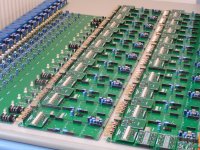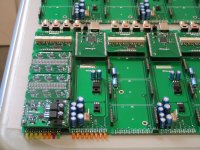Oh, so the first batch was the T not uv?I have a schiit yggdrasil and the mosaic T
will also buy the Mosaic UV when it comes out and get it in here!
ill report then
How lucky or should I say jammy are you! How does the Mosaic compare to the yaggy then?
Hi folks, I would really like to here from the owners of the first batch of Mosaic-UV buyers, ive done a few searches and found none, yet the first run sold out in a few days. I have just purchased a Schiit Gungnir multibit, its opened my ears and eyes to the effect a well designed DAC can have on my music, I wish I had seen Johns design first though. I will not be able to afford both for comparison so as so many do I would like to here from current owners before I bite the bullet and sell the Schiit, its the first product ive heard in more than a decade that has made me sit and listen to music again. (thanks to a new speaker and amp purchase)
If I may ask, what were you using earlier before you got the Gumby?
If I may ask, what were you using earlier before you got the Gumby?
I have had a few bits and bobs, the last was one of these, Assembled DAC board XMOS U8 + AK4490 USB decoder board | eBay Before that I had an smsl-m8, I purchased an Audiolab M-DAC but I sold that after a couple of weeks, its not just a comparison of DACs though, its all the other stuff ive had in my system, Ive had a lot of cdps including the sony scd-1,(5k but 1k when you know someone who gets graded sony gear) I have modified a fair few to run on valves aka Lampizator, I also had an AMR-77 for about 3 months on loan. Ive been in this game for about 30 years and ive spent a small fortune as you do, Ive been to a lot of shows and I cant afford most of whats on offer hens the DIY route, so I havnt had anything really esoteric. I was beginning to think my hearing was shot to **** due to my age (I consider over 50 a sad time for an audiophile) but I took a gamble on the Gumby, now I feel my ears are 25 again. (as I said this is also probably helped by my latest amp and speaker purchase) So im wondering if theres even more life in these old ears and Im wondering if its available for the asking price of the Mosaic-UV, I dont know whether im prepared to take another gamble though which involves selling the Schiit so Im going to have to listen to people with more money than me, of course its my system and lounge that counts but unless someone lends me one thats my options.
Out of curiosity, does anyone know what chips the schiit dacs use?
Depends which one you buy, Gungnir is ak4399 and Gungnir Multibit AD5781BRUZ.m
Out of curiosity, does anyone know what chips the schiit dacs use?
I have datasheets of a couple of the chips on my blog - http://www.diyaudio.com/forums/blog...tts-flagship-dac-uses-not-audio-dac-chip.html
I have datasheets of a couple of the chips on my blog - http://www.diyaudio.com/forums/blog...tts-flagship-dac-uses-not-audio-dac-chip.html
How come we haven't seen any DIY attempts with these chips yet?
At the risk of going OT I'd suggest its mainly to do with the fact they're parallel input, meaning some logic or ucontroller's needed for interfacing. DIYers tend to prefer simple I2S. In the case of the AD5791 there's a huge fly in the ointment - it needs a deglitcher to sound good and I'm not aware of any suitable schematics in the public domain.
Last edited:
Hi paul_peraic,
I attached some pictures of the PCBs I already assembled. It's taking much longer than expected.
The boards were outsourced at this company:
https://www.pcbway.com
Next up are the housings.
Any news on the Mosaic UV
I attached some pictures of the PCBs I already assembled. It's taking much longer than expected.
The boards were outsourced at this company:
https://www.pcbway.com
Next up are the housings.
Attachments
Hi paul_peraic,
I attached some pictures of the PCBs I already assembled. It's taking much longer than expected.
The boards were outsourced at this company:
https://www.pcbway.com
Next up are the housings.
Thanks John .
You can put me down for one .
Last edited:
Excellent writeup Abrax, very good reading indeed. I´m back to building and studying analog electronics...I have datasheets of a couple of the chips on my blog - http://www.diyaudio.com/forums/blog...tts-flagship-dac-uses-not-audio-dac-chip.html
John, in your brief I read:
My2cnts
However it is my huntch that it should be possible to do just this, by using the FM-stereo decoder set-up. It should not be hard to prepare such a signal. In fact, Philips once went the other way by decoding FM digitally (I had such a reciever).Er wordt geadviseerd om sinusgolven te gebruiken om EM straling te voorkomen voor zeer gevoelige circuits zoals AD conversie. Voor DA conversie worden echter blokgolven gebruikt. Sinusgolven zijn waarschijnlijk ongeschikt voor DA conversie omdat dit resulteert in tijdsdomein fouten omdat een spanningsreeks wordt gezien als "0" en een andere spanningsreeks wordt gezien als "1".
My2cnts
----------------------------------...At first I tried NOS mode and I was amazed. Amazed how people can listen to it like this, I mean, it's so distorted..
Later I used SAA7220 and it's much better, music sounds like music..
Can anybody explain to me that phenomena?...
I wish I could compare my build with others, maybe I got something wrong?
Hello Holgin.
I think John and his team have done a truly wonderful job of getting to the very root of the design issues
involved in creating a world class DAC. I think many diy:ers are greatful for his sharing his ideas with the
rest and I thank him for that.
I started following his efforts 10 years ago and I admire his work, since I know how difficult and time consuming
it is to arrive at new ideas.
I built my share of NOS dacs in the earlly 90:s, modifying CD players, upgrading analog stages, Power supplies, and so on....
...But my observations were like yours:
Every time I simplified or improved PSU section, the sound improved.
Every time I improved clock generators the sound improved.
Every time I improved the analog stage, the sound improved.
But the NOS sound always left me very unsatisfied.
I have commented on this earlier.
Below you'll find a copy/paste of I just what I wrote earlier. Please share your ideas on this:
......................................................................................................................................................................................
Skipping the digital filter (NOS) necessitates very steep analogue filters that require time, effort and more
importantly - competence to design, specially if the designer aims to make them sing.
The usual shelved-HP filters, often seen on the NOS Dac outputs really don't solve anything.
As mentioned earlier, I think the problem of some individuals not finding the NOS designs sonically satisfying
might be more neurological than technical.
It appears some people (maybe 2 - 5 % of people) have auditory systems that are, for some unknown reason, sensitive to the NOS artifacts that are not
harmonically related to the music.
I did my share of NOS-making in the 90's.
Although the low frequencies sounded amazing, there was a very bad, unnatural quality to the rendition that always made me
question - my mods at first, and then the NOS idea later on.
The R-ladder Dacs are interesting in that they can do without the high clock rates necessary for bitstream modulation.
Lowering the clock frequency leads to lower jitter, lower noise, lower radiation, more effective
grounding, less glitching, more effective PSUs, less .....
I have found all R2R dacs to be uncomfortable with higher clocks and bit-rates.
This might be one of the reasons behind the NOS appeal => bringing the switching frequencies down to the levels
required by NOS operation improves the internal circuit performance of multibit dacs.
......................................................................................................................................................................................
Last edited:
I find the bass area odd with TDA1541 (in simultaneous mode with Crysteq XO 45/49.xxx speed) on some high res reccording : 24/192 or 32/380. Miles Davis Kind of Blue for instance... or Stan Getz Gilberto Gill famous album I have both in normal and high res.
The medium & treble are always better but not Something to mess up as hunting high resolution reccording to swapp the old 16/41 collection !
I don't know if the odd bass (not as tight) is because the different bit depth (24 or 32 bits) or because the sampling frequency !
Test made with a TDA1541 single Crown and all the fifo/isolator/clock and very low noise PSU! No oversampling (filter chip) between the SOURCE and the dac chip.
But not too much experience to have a definitive idea !
The medium & treble are always better but not Something to mess up as hunting high resolution reccording to swapp the old 16/41 collection !
I don't know if the odd bass (not as tight) is because the different bit depth (24 or 32 bits) or because the sampling frequency !
Test made with a TDA1541 single Crown and all the fifo/isolator/clock and very low noise PSU! No oversampling (filter chip) between the SOURCE and the dac chip.
But not too much experience to have a definitive idea !
I have some comparable experiences to Alexis. TDA1541 NOS is harder to listen to than TDA1543 in NOS, that has a 'modern' (musically wise) sound. Once went to a concert, played the tracks again out loud with TDA1543 NOS and this was my exact recollection. Great.
TDA1541 with SAA7220 and resistor I/V I have found very subtle, and with Pass I/V it gives great depth. (I have a depth-enhancing 300B SET).
Note that with a passive preamp it is much better; while any active preamplifier might sound tense.
But that is in my home with my ears (certainly not going above 13k anymore, right even less, and I'm very sensitive to fast transients that quickly are heard as harsh highs).
TDA1541 with SAA7220 and resistor I/V I have found very subtle, and with Pass I/V it gives great depth. (I have a depth-enhancing 300B SET).
Note that with a passive preamp it is much better; while any active preamplifier might sound tense.
But that is in my home with my ears (certainly not going above 13k anymore, right even less, and I'm very sensitive to fast transients that quickly are heard as harsh highs).
- Home
- Source & Line
- Digital Line Level
- Building the ultimate NOS DAC using TDA1541A

